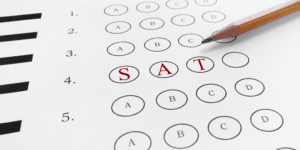Kindergarten cutoff dates have been gradually standardizing for years, and nationally, most are now predominantly clustered in the fall. These changes ostensibly ensure that students are more capable when they begin than children in the past.
***
One boy in Oakland, California missed the kindergarten cutoff by five hours, having been born at 5 a.m. on September 2 five years earlier.
His parents, his preschool director, and the principal of the local elementary school all agreed that he was ready for kindergarten. He was almost four feet tall, and had been in the 99th percentile for height his entire life. He was an only child of a stay-at-home mother, and had attended a Spanish-English dual language preschool program for two years. He was, according to all of the adults in his life, socially and cognitively ready for kindergarten.
The District Cutoff Date
But the Oakland Unified School District pushed back, saying that it was firm on cutoff dates. “They said everyone born on this date has to go into the transitional program,” said his mother Shay, referring to California’s pre–K/K program for children whose ages fall between preschool- and kindergarten-aged. It wasn’t until five days before school started that she was able to persuade the principal to enroll her son in kindergarten. She felt enormous relief after the frustration of having gone up against a kindergarten cutoff.
“He is exactly where he should have been. It could have affected his whole life,” said Shay, who wanted her son to be challenged. “We would rather have him as an underdog … than an overachiever. We always encourage him to seek out things that are beyond him.”
And therein lies but one of the issues with kindergarten cutoff dates: These rules, which seek to impose a degree of uniformity on the age ranges of kindergarten classes by defining when children are ready to begin, obscure the fact that kids mature at different rates. And even if all students were close to the same age in each class, in truth, there would still be wide variation in their social and cognitive development; similar birth dates may mask this.
The Age of Kindergartners in the Past
In the past, children started kindergarten when they were around 5 years old — if you were one of those hand-raising, number-spouting, pre-5-year-olds who could pronounce “photosynthesis,” then you went a little early. Tall or socially dominant (some called them bossy) children, or those whose parents worked outside the home, might begin kindergarten as early as possible, perhaps when the kids were in their early 4s. And others began when they were on the latter half of their 5s.
Essentially, children went to kindergarten when parents thought they should go, and sometimes, when they needed them to go. What was the harm? It consisted of playing and play dough and finger-painting, and if children had trouble, they just repeated the kindergarten year while they got used to the experience of school.
The Standardization of the Cutoff Date
But the landscape of kindergarten is changing, and nowhere is that more apparent than with the cutoff date — that magical, somewhat arbitrary threshold that determines when a child will leave the family nest and march toward the big, fluorescent lights of the education system.
Kindergarten cutoff dates have been gradually standardizing for years, and nationally, most are now predominantly clustered in the fall. These changes ostensibly ensure that students are more capable when they begin than children in the past. Those school districts that enforce compulsory policies, moreover, do so in order to ensure that classes are comprised of similarly-aged cohorts of students.
Even if all students were close to the same age in each class, in truth, there would still be wide variation in their social and cognitive development; similar birth dates may mask this.
Many parents want — or need — to send their child to public kindergarten in order to avoid paying for a full-time preschool program that can run to $30,000 per year in some communities. Indeed, one South Dakota kindergarten teacher observed that when their schools went to full-day kindergarten, more parents sent kids who were on the cusp. “It’s free daycare for all day. Why would parents pay $800 a month?” she asked. And even if their child doesn’t seem completely ready for the experience, parents count on the school to address individual kids’ needs.
Still, many parents with kids whose birthdays are near the cutoff dates — both those who want to enroll their relatively young children and those who opt to redshirt their children — often find resistance from the district if they have strong feelings about their child’s readiness.
The Considerations of Parents
The issue of when to begin kindergarten has implications beyond merely assessing the “readiness” of a 5-year-old, as parents project forward and imagine their child in the not-so-distant future. Do they want her to be the first of her friends to get a license, or to turn 18 — a legal adult — during her senior year in high school?
Would a bored, older kid have a greater tendency to be a bully to younger classmates, or consistently take the easy road because it’s all she’s known? And conversely, as the youngest, will their child be the shortest, the one to go through puberty last, and, hence, the one at risk of being bullied?
Getting in Early
Some parents whose children have barely missed their district’s cutoff date go to impressive lengths to get their youngsters into a kindergarten class with their peers.
In Oregon, kids must be 5 years old on or before September 1 of the year they enroll in kindergarten. If children are born after this date and want to begin public school, parents can petition to have their child take a test to assess kindergarten readiness. One parent said the assessment required children to write the alphabet, both capital and lowercase letters, and to count to 150. The exam was administered by a psychologist and cost the family around $300.
“The test was insanely hard,” remembered this mother of a then-4-year-old.
Back when California had a later cutoff date than Oregon, another mother moved with her daughter (temporarily) to the grandmother’s California home to begin kindergarten for a month. That way, the daughter could transfer back to the family’s Bend, Oregon school — since interstate transfers were permitted for kindergartners who wouldn’t have made the cutoff date as Oregon residents.
Similarly, a New Jersey mom sent her October-born daughter to school in Connecticut for a single week before returning with her now-official kindergartener to begin in their town’s public elementary school — which had refused to budge from its October 1 cutoff date, but would, like Oregon, accept an out-of-state transfer who had already begun kindergarten.
Parents have been known to fake temporary divorces, forward mail to addresses where they don’t live, hire tutors, and pay for pricey tests to get children who are on the cutoff-cusp into kindergarten.
Opting to Wait
On the other hand, there are parents who remember their own negative experiences having been among the youngest in their grade; many of these parents may seek a different path for their own children.
Geri and Bill, for instance, have a daughter whose birthday is two weeks past their district’s cutoff. Despite the fact that she is bright and tall, they thought it would be best for her to be one of the oldest children in the class. Bill’s experience as a young student had a lot to do with their decision. “He never understood his peers,” said Geri, an active school volunteer and former family therapist. “To him, everything was a blur … he retreated. He was bullied until he was 16.”
Betsy, a former math teacher of 10 years, has two children with birthdays that just missed their school’s cutoff. She could have skirted the rules and sent her kids to kindergarten early, but opted to wait and go along with the policy. Her husband had been among the youngest in his class, and felt acutely less mature than his peers for most of his school years.
Her children are now 13 and 11, and with her elder now in middle school, she is confident that his maturity helps him with school and its accompanying activities.“It definitely benefited him. I just don’t worry about him at all. He is so ready to do all of those things, like overnight field trips,” his mom observed.
Patricia, a mother of three whose youngest child missed the kindergarten cutoff date by mere days, is keeping her daughter at the Montessori preschool she’s been attending. On starting kindergarten, Patricia noted, “They said she’s ready. But I see it as robbing her of a year of childhood. Kindergarten now is really strict. You are in there for academic purposes. They learn to read in kindergarten. It used to be about playing and socializing.”
Patricia remembers that when she was taught to read in first grade, it came quickly and naturally. Her older children struggled when they faced the same subject in kindergarten. “They weren’t quite ready to learn to read,” she said, recalling the “prolonged agony” of helping her children get through kindergarten reading.
The Definition of “Readiness”
On the increasing expectations placed on kindergartners, experts tend to agree. “There is more push-down curriculum,” said Fabienne Doucet, New York University professor of early education. “A lot of kindergarten classrooms look like first grade a few years ago.”
“What has happened is our definition of what readiness is has become more demanding. What we consider ready in kindergarten [now] is dramatically different than [it was in] 1960,” said Doucet. Given the increasing academic focus of kindergarten, more parents are hitting the brakes, particularly when they remember their own play-based kindergarten experiences.
And many teachers agree. One educator recounted, “Before, I was always, ‘Send them, send them. If they are the right age, the schools are ready for them.’ But now, having taught [kindergarten], I would encourage more parents to wait. The Common Core Standards are very rigorous. It is pretty lofty what they expect of our kindergartners.” While she added that she is a fan of the Common Core, it has changed kindergarten as she knows it.
Jessica, a Connecticut teacher since 1997, was working with a boy who would turn 5 at the end of December — a birthday that, according to Connecticut guidelines, meant he was supposed to be in kindergarten.
“He was clearly behind socially and emotionally. While he was academically near-par, he did not have the stamina nor the maturity of his peers — some of whom were 16 months ahead of him due to redshirting. … As a teacher, I need to grapple with the question of whether these students are struggling because of their age-appropriate needs, because of an amped-up curriculum based on the Common Core, or because of a learning issue that should be dealt with sooner rather than later.”
Play in Kindergarten
Even though many kindergartens have swung toward a more academic, directed-learning approach, those who study these educational settings find a massive range that also includes classrooms with vibrant play areas.
“It’s a hugely complex space,” said Kyle Snow, a quantitative analyst and director of the Center for Applied Research at the National Association for the Education of Young Children (NAEYC). “Kindergarten is a fascinating time.” He said that young minds are wildly integrative and that play is the most natural acquisition of knowledge for kids of this age. “Spending time playing with other kids is probably going to help your child get into an Ivy League school more so than sitting in front of a book all day.”
“Fundamentally, most parents want what is best for their kids. A lot of times, parents’ concern is not met with the best information,” he noted.
Studies that track academic success and kindergarten age abound, but most experts and parents suggest that being in the middle of the range is probably the most desirable situation.
Gera Jacobs, professor of Early Childhood and Elementary Education at the University of South Dakota and former president of the National Association for the Education of Young Children, advocates for more play, less testing, and more teacher-driven curricula in kindergarten programs. And Jacobs favors sending kids to school with their peers. Reading to preschool-aged children, letting them help out around the house, and doing activities will help prepare children for school, she said.
The Practice of Redshirting
While most kindergarten cutoff dates in the U.S. are in September or October, there is still a wide range of standards. According to the National Center for Education Statistics (NCES), Hawaii and Nebraska have the earliest at July 31, with Connecticut — and some local school districts, including New York City — following a much later timeline that runs through December 31. Knowing this, one might understandably infer that states like Connecticut always have some of the youngest kindergartners across the country — but this is not the case.
Not too long ago, my family moved with our young children (who were born in August and November) from New York City to a town in Connecticut. As our kids began at their new school, we were very impressed with their classmates, who seemed so polished, tall (for the most part), and mature. What a place, we thought! As the birthday party invitations started to roll in, though, we discovered that many of our children’s classmates were an entire year older than our own. Their parents had delayed enrolling them in kindergarten — a practice known as redshirting.
This isn’t hard to do in Connecticut, which, in contrast to New York City’s strictly-enforced age guidelines, permits parents to hold off enrolling their child in kindergarten for an extra year. As it turns out, some 28 percent of eligible children in the state delay starting kindergarten, according to an official at the Connecticut State Department of Education. While there is some debate about the figures, the National Center for Education Statistics reports that about six percent of eligible U.S. kindergartners put off starting school in 2010.
Effects of Redshirting
Academic redshirting can be challenging for schools and teachers alike. “You are manipulating the experience,” says Snow, “You are creating a broader range of ages in the classrooms that makes it more challenging for the kindergarten teacher.”
Along with the difficulties that arise in trying to teach children across an even broader spectrum of developmental and cognitive stages, redshirting has socioeconomic implications, as well. Redshirting is typically only possible for students whose families can afford an additional year of preschool. “I actually find it to be really problematic. It tends to be middle-class, white families who have access to capital,” said Doucet. “It creates this natural disparity within the kindergarten classrooms, which then leads to a bunch of other issues.”
She went on to speculate that having a kindergarten class with younger, low-income kids whose parents likely couldn’t afford an extra year of preschool, in the same class with older, middle or high-income children who had been redshirted, could further exacerbate the documented achievement gaps whose seeds are often already present when children enter school.
The Heart of the Matter
The funny thing about this entire issue is that kindergarten isn’t mandatory in much of the country. It is only required in the District of Columbia and 15 states, meaning that it is optional in 35 states. The importance placed on kindergarten, Doucet suggested, may have a bit more to do with parental anxiety and “trying to get your kid into Harvard.” “All parents want what is best for their child. If they have [redshirting] at their disposal, they are going to do it,” she said — despite the fact that new data cast doubt on the efficacy of the practice.
Studies that track academic success and kindergarten age abound, but most experts and parents suggest that being in the middle of the range is probably the most desirable situation. It may be that the kindergarten start date is over-thought. Just send your kids when you should, advise some experts.
“If the kids are age-eligible, they should come to kindergarten,” said Jacobs. She suggested parents whose children’s birthdays are near the cusp visit the kindergartens and see what is expected in the class to determine if it would be a good fit — though, of course, exercising this choice may also depend on a district’s flexibility and a family’s resources.
There will always be older and younger children in a class, and sometimes, age is simply one factor among many. “Age — at best — is an imperfect predictor of where a child’s developmental and learning space is,” said Snow.




